Poly(3,4-ethylenedioxythiophene) Based Solid-State Polymer Supercapacitor with Ionic Liquid Gel Polymer Electrolyte
Abstract
1. Introduction
2. Experimental
2.1. Materials
2.2. Preparation of PEDOT/CP Electrode Material
2.3. Fabrication of Gel Polymer Electrolytes and Solid-State Supercapacitors
2.4. Electrochemical Performance Test
2.5. Differential Scanning Calorimetry (DSC)
3. Results and Discussion
3.1. Macrographs and SEM images of CP and PEDOT/CP
3.2. The Cyclic Voltammetry Test of SSC Based on Different Electrolytes
3.3. The Galvanostatic Charge–Discharge Test
3.4. The Electrochemical Impedance Spectroscopy Test
3.5. The Energy Density and Power Density Test
3.6. The Effect of Freezing–Thawing Cycles on the Electrochemical Properties of SSC
3.7. The Effect of Freezing–Thawing Cycles on the Thermal Properties of SSC-IL/ PVA/H2SO4
3.8. The Mechanical Properties and Function of Ionic Liquid-Based Polymer Gel
4. Conclusions
Author Contributions
Funding
Conflicts of Interest
References
- Zhang, J.; Sun, J.B.; Hu, Y.; Wang, D.; Cui, Y.B. Electrochemical Capacitive Properties of All-solid-state Supercapacitors Based on Ternary MoS2/CNTs-MnO2 Hybrids and Ionic Mixture Electrolyte. J. Alloys Compd. 2019, 780, 276–283. [Google Scholar] [CrossRef]
- Zhai, T.; Lu, X.H.; Wang, F.X.; Xia, H.; Tong, Y.X. MnO2 Nanomaterials for Flexible Supercapacitors: Performance Enhancement Intrinsic and Extrinsic Modification. Nanoscale Horiz. 2016, 1, 109–124. [Google Scholar] [CrossRef]
- Oh, S.M.; Patil, S.B.; Jin, X.Y.; Hwang, S.J. Recent Applications of 2D Inorganic Nanosheets for Emerging Energy Storage System. Chem. Eur. J. 2018, 24, 4757–4773. [Google Scholar] [CrossRef]
- Xu, Y.X.; Li, B.; Zheng, S.S.; Wu, P.; Zhan, J.Y.; Xue, Q.X.; Pang, H. Ultrathin Two-dimensional Cobalt-organic Framework Nanosheets for High-performance Electrocatalytic Oxygen Evolution. J. Mater. Chem. 2018, 6, 22070–22076. [Google Scholar] [CrossRef]
- Abidin, S.N.J.S.Z.; Mamat, M.S.; Rasyid, S.A.; Zainal, Z.; Sulaiman, Y. Electropolymerization of Poly(3,4-ethylenedioxythiophene) onto Polyvinyl Alcohol-graphene Quantum Dot-cobalt Oxide Nanofiber Composite for High-performance Supercapacitor. Electrochim. Acta 2018, 261, 548–556. [Google Scholar] [CrossRef]
- Zhou, H.H.; Zhi, X.M. Surfactant-assisted Potentiodynamically Polymerized PEDOT Fibers for Significantly Improved Electrochemical Capacitive Properties. Mater. Lett. 2018, 221, 309–312. [Google Scholar] [CrossRef]
- Navarrete-Astorga, E.; Rodríguez-Moreno, J.; Dalchiele, E.A.; Schrebler, R.; Leyyon, P.; Ramos-Barrado, J.R.; Martín, F. A Transparent Solid-state Ion Gel for Supercapacitor Device Applications. J. Solid State Electrochem. 2017, 21, 1431–1444. [Google Scholar] [CrossRef]
- Bao, Q.L.; Wu, J.H.; Fan, L.Q.; Ge, J.H.; Dong, J.; Zeng, J.L.; Lin, J.M. Electrodeposited NiS2 on Carbon Fiber Cloth as a Flexible Electrode for High-performance Supercapacitors. J. Energy Chem. 2017, 26, 1252–1259. [Google Scholar] [CrossRef]
- Fan, L.Q.; Zhong, J.; Wu, J.H.; Huang, Y.F. Improving the Energy Density of Quasi-solid-state Electric Double-layer Capacitors by Introducing Redox Additives into Gel Polymer Electrolytes. J. Mater. Chem. 2014, 2, 9011–9014. [Google Scholar] [CrossRef]
- Sun, K.J.; Ran, F.T.; Zhao, G.H.; Zhu, Y.R.; Zheng, Y.P.; Ma, M.G.; Zheng, Y.P.; Ma, G.F.; Lei, Z.P. High Energy Density of Quasi-solid-state Supercapacitor Based on Redox-mediated Gel Polymer Electrolyte. RSSC Adv. 2016, 6, 55225–55232. [Google Scholar] [CrossRef]
- Zhang, Y.Z.; Wang, Y.; Cheng, T.; Lai, W.Y.; Pang, H.; Huang, W. Flexible Supercapacitors Based on Paper Substrates: A New Paradigm for Low-cost Energy Storage. Chem. Soc. Rev. 2015, 44, 5181–5199. [Google Scholar] [CrossRef] [PubMed]
- Shao, Y.L.; El-Kady, M.F.; Sun, J.; Li, Y.; Zhang, Q.; Zhu, M.; Wang, H.; Dunn, B.; Kaner, R.B. Design and Mechanisms of Asymmetric Supercapacitors. Chem. Rev. 2018, 118, 9233–9280. [Google Scholar] [CrossRef] [PubMed]
- Pandey, G.P.; Rastogi, A.C.; Westgate, C.R. All-solid-state Supercapacitors with Poly(3,4-ethylenedioxythiophene)-coated Carbon Fiber Paper Electrodes and Ionic Liquid Gel Polymer Electrolyte. J. Power Sources 2014, 245, 857–865. [Google Scholar] [CrossRef]
- Kang, Y.J.; Chun, S.J.; Lee, S.S.; Kim, B.Y.; Kim, J.H.; Chung, H.; Lee, S.Y.; Kim, W. All-Solid-State Flexible Supercapacitors Fabricated with Bacterial Nanocellulose Papers, Carbon Nanotubes, and Triblock-Copolymer Ion Gels. ACS Nano 2012, 6, 6400–6406. [Google Scholar] [CrossRef]
- Tiruye, G.A.; Munoz-Torrero, D.; Palma, M.A.; Marcilla, R. All-solid State Supercapacitors Operating at 3.5 V by Using Ionic Liquid Based Polymer Electrolytes. J. Power Sources 2015, 279, 472–480. [Google Scholar] [CrossRef]
- Fei, H.J.; Yang, C.Y.; Bao, H.; Wang, G.C. Flexible All-solid-state Supercapacitors Based on Graphene/carbon Black Nanoparticle Film Electrodes and Cross-linked Poly(vinyl alcohol)-H2SO4 Porous Gel Electrolytes. J. Power Sources 2014, 266, 488–495. [Google Scholar] [CrossRef]
- Kang, Y.J.; Yoo, Y.J.; Kim, W. 3-V Solid-State Flexible Supercapacitors with Ionic-Liquid-Based Polymer Gel Electrolyte for AC Line Filtering. ACS Appl. Mater. Interfaces 2016, 8, 13909–13917. [Google Scholar] [CrossRef]
- Liew, C.W.; Arifin, K.H.; Kawamura, J.; Iwai, Y.; Ramesh, S.; Arof, A.K. Effect of Halide Anions in Ionic Liquid added Poly(vinyl alcohol)-based Ion Conductors for Electrical Double Layer Capacitors. J. Non Cryst. Solids 2017, 458, 97–106. [Google Scholar] [CrossRef]
- Jang, H.S.; Raj, C.J.; Lee, W.G.; Kim, B.C.; Yu, K.H. Enhanced Supercapacitive Performances of Functionalized Activated Carbon in Novel Gel Polymer Electrolytes with Ionic Liquid Redox-mediated Poly(vinyl alcohol)/phosphoric Acid. RSC Adv. 2016, 6, 75376–75383. [Google Scholar] [CrossRef]
- Jeong, H.T.; Du, J.F.; Kim, Y.R. Development of Flexible Energy Storage Device by Using Polymer Electrolyte Based on Ionic Liquid. Chem. Select 2017, 2, 6057–6061. [Google Scholar] [CrossRef]
- Zhang, J.; Zhang, W.; Guo, J.N.; Yuan, C.; Yan, F. Ultrahigh Ionic Liquid Content Supramolecular Ionogels for Quasi-Solid-State Dye Sensitized Solar Cells. Electrochim. Acta 2015, 165, 98–104. [Google Scholar] [CrossRef]
- Zhang, L.; Li, Y.W.; Liu, Q.; Li, W.X.; Xing, W.H. Fabrication of Ionic Liquids-functionalized PVA Catalytic Composite Membranes to Enhance Esterification by Pervaporation. J. Membr. Sci. 2019, 584, 268–281. [Google Scholar] [CrossRef]
- Gu, Y.Y.; Zhang, S.P.; Martinetti, L.; Lee, K.H.; McIntosh, L.D.; Frisbie, C.D.; Lodge, T.P. High Toughness, High Conductivity Ion Gels by Sequential Triblock Self-Assembly and Chemical Cross-Linking. J. Am. Chem. Soc. 2013, 135, 9652–9655. [Google Scholar] [CrossRef] [PubMed]
- Moon, H.C.; Lodge, T.P.; Frisbie, C.D. Solution-Processable Electrochemiluminescent Ion Gels for Flexible, Low-Voltage, Emissive Displays on Plastic. J. Am. Chem. Soc. 2014, 136, 3705–3712. [Google Scholar] [CrossRef] [PubMed]
- Tang, B.X.; White, S.P.; Frisbie, C.D.; Lodge, T.P. Synergistic Increase in Ionic Conductivity and Modulus of Triblock Copolymer Ion Gels. Macromolecules 2015, 48, 4942–4950. [Google Scholar] [CrossRef]
- Seo, D.G.; Moon, H.C. Mechanically Robust, Highly Ionic Conductive Gels Based on Random Copolymers for Bending Durable Electrochemical Devices. Adv. Funct. Mater. 2018, 28, 1706948. [Google Scholar] [CrossRef]
- Kim, Y.M.; Seo, D.G.; Oh, H.; Moon, H.C. A Facile Random Copolymer Strategy to Achieve Highly Conductive Polymer Gel Electrolytes for Electrochemical Applications. J. Mater. Chem. C 2019, 7, 161–169. [Google Scholar] [CrossRef]
- Hwang, H.; Park, S.Y.; Kim, J.K.; Kim, Y.M.; Moon, H.C. Star-Shaped Block Copolymers: Effective Polymer Gelators of HighPerformance Gel Electrolytes for Electrochemical Devices. ACS. Appl. Mater. Interfaces 2019, 11, 4399–4407. [Google Scholar] [CrossRef]
- Masouras, A.; Giannopoulos, D.; Hasa, B.; Katsaounis, A.; Kostopoulos, V. Hybrid Graphene Nanoplatelet/Manganese Oxide Electrodes for Folid-state Supercapacitors and Application to Carbon Fiber Composite Multifunctional Materials. J. Energy Storage 2019, 23, 515–525. [Google Scholar] [CrossRef]
- Wang, L.; Zhu, H.J.; Zhai, W.; Cai, F.; Liu, X.M.; Yang, H. Study of a Novel Gel Electrolyte Based on Poly-(methoxy/hexadecyl-poly(ethylene glycol) methacrylate) Co-polymer Plasticized with 1-butyl-3-methylimidazolium Tetrafluoroborate. RSC Adv. 2014, 4, 36357. [Google Scholar] [CrossRef]
- Shown, I.; Ganguly, A.; Chen, L.C.; Chen, K.H. Conducting Polymer-based Flexible Supercapacitor. Energy Sci. Eng. 2015, 3, 2–26. [Google Scholar] [CrossRef]
- Du, X.; Hao, X.G.; Wang, Z.D.; Ma, X.L.; Guan, G.Q.; Abuliti, A.; Ma, G.Z.; Liu, S.B. Highly Stable Polypyrrole Film Prepared by Unipolar Pulse Electro-polymerization Method as Electrode for Electrochemical Supercapacitor. Synth. Metals 2013, 175, 138–145. [Google Scholar] [CrossRef]
- Chaudoy, V.; Tran Van, F.; Deschamps, M.; Ghamouss, F. Ionic Liquids in a Poly Ethylene Oxide Cross-linked Gel Polymer as an Electrolyte for Electrical Double Layer Capacitor. J. Power Sources 2017, 342, 872–878. [Google Scholar] [CrossRef]
- Pandey, G.P.; Rastogi, A.C. Solid-State Supercapacitors Based on Pulse Polymerized Poly(3,4-ethylenedioxythiophene) Electrodes and Ionic Liquid Gel Polymer Electrolyte. J. Electrochem. Soc. 2012, 159, A1664–A1671. [Google Scholar] [CrossRef]
- Kelly, T.L.; Yano, K.; Wolf, M.O. Supercapacitive Properties of PEDOT and Carbon Colloidal Microspheres. Appl. Mater. Interfaces 2009, 1, 2536–2543. [Google Scholar] [CrossRef] [PubMed]
- Osterholm, A.M.; Shen, D.E.; Dyer, A.L.; Reynolds, J.R. Optimization of PEDOT Films in Ionic Liquid Supercapacitors: Demonstration as a Power Source for Polymer Electrochromic. Appl. Mater. Interfaces 2013, 5, 13432–13440. [Google Scholar] [CrossRef] [PubMed]
- Lehtimaki, S.; Suominen, M.; Damlin, P.; Tuukkanen, S.; Kvarnstrom, C.; Lupo, D. Preparation of Supercapacitors on Flexible Substrates with Electrodeposited PEDOT/Graphene Composites. Appl. Mater. Interfaces 2015, 7, 22137–22147. [Google Scholar] [CrossRef]
- Du, H.Y.; Liu, X.X.; Ren, Z.; Yang, H.M.; Yu, Y.L. Capacitance Properties of Unipolar Pulsed Electro-polymerized PEDOT Films. J. Appl. Polym. Sci. 2018, 135, 46729. [Google Scholar] [CrossRef]
- Wang, J.J.; Dong, L.B.; Xu, C.J.; Ren, D.Y.; Ma, X.P.; Kang, F.Y. Polymorphous Supercapacitors Constructed from Flexible Three-Dimensional Carbon Network/Polyaniline/MnO2 Composite Textiles. ACS Appl. Mater. Interfaces 2018, 10, 10851–10859. [Google Scholar] [CrossRef]
- Yin, T.; Lin, Z.Y.; Su, L.; Yuan, C.W.; Fu, D.G. Preparation of Vertically Oriented TiO2 Nanosheets Modified Carbon Paper Electrode and Its Enhancement to the Performance of MFCs. ACS Appl. Mater. Interfaces 2015, 7, 400. [Google Scholar] [CrossRef]
- Wu, Z.K.; Li, L.Y.; Lin, Z.Y.; Song, B.; Li, Z.; Moon, K.-S.; Wong, C.-P.; Bai, S.L. Alternating Current Line-Filter Based on Electrochemical Capacitor Utilizing Template-Patterned Graphene. Sci. Rep. 2015, 5, 10983. [Google Scholar] [CrossRef] [PubMed]
- Wu, Z.S.; Liu, Z.Y.; Parvez, K.; Feng, X.L.; Mullen, K. Ultrathin Printable Graphene Supercapacitors with AC Line-Filtering Performance. Adv. Mater. 2015, 27, 3669–3675. [Google Scholar] [CrossRef] [PubMed]
- Cheng, Y.; Pang, K.L.; Xu, X.H.; Yuan, E.F.; Zhang, Z.G.; Wu, X.; Zheng, I.R.; Zhang, J.A.; Song, R. Borate Crosslinking Synthesis of Structure Tailored Carbon-Based Bifunctional Electrocatalysts Directly from Guar Gum Hydrogels for Efficient Overall Water Splitting. Carbon 2019, 157, 153–163. [Google Scholar] [CrossRef]
- Chen, G.Z. Understanding Supercapacitors based on Nano-hybrid Materials with Interfacial Conjugation. Prog. Nat. Sci. Mater. 2013, 23, 245–255. [Google Scholar] [CrossRef]
- Wang, L.; Tan, H.X.; Chen, J.; Zhang, H.J.; Li, Z.; Qiu, H.D. Porous Graphene Synthesized by Partial Combustion for High-performance Supercapacitors. Mater. Lett. 2019, 252, 345–348. [Google Scholar] [CrossRef]
- Peng, H.; Lei, Z.; Lv, Y.; Wei, G.; Zhou, J.; Gao, X.; Sun, K.; Ma, G.; Lei, Z. A flexible and Self-healing Hydrogel Electrolyte for Smart Supercapacitor. J. Power Sources 2019, 431, 210–219. [Google Scholar] [CrossRef]
- Farah, N.; Ng, H.M.; Numan, A.; Liew, C.W.; Latip, N.A.A.; Ramesh, K.; Ramesh, S. Solid Polymer Electrolytes based on Poly(vinyl alcohol) Incorporated with Sodium Salt and Ionic Liquid for Electrical Double Layer Capacitor. Mater. Sci. Eng. B 2019, 251, 114468–114475. [Google Scholar] [CrossRef]
- Lalia, B.S.; Alkaabi, M.; Hashaikeh, R. Sulfated Cellulose/Polyvinyl Alcohol Composites as Proton Conducting Electrolyte for Capacitors. Energy Procedia 2015, 75, 1869–1874. [Google Scholar] [CrossRef][Green Version]
- Wu, T.F.; O’Kelly, K.; Chen, B.Q. Poly(vinyl alcohol) Particle-reinforced Elastomer Composites with Water-active Shape-Memory Effects. Eur. Polym. J. 2014, 53, 230–237. [Google Scholar] [CrossRef]
- Guo, L.; Zhang, H.J.; Fortin, D.; Xia, H.S.; Zhao, Y. Poly(vinyl alcohol)-Poly(ethylene glycol) Double-Network Hydrogel: A General Approach to Shape Memory and Self-healing Functionalities. Langmuir 2015, 31, 11709–11716. [Google Scholar]
- Hong, H.Q.; Liao, H.Y.; Chen, S.J.; Zhang, H.Y. Facile Method to Prepare Self-Healable PVA Hydrogels with High Water Stability. Mater. Lett. 2014, 122, 227–229. [Google Scholar] [CrossRef]
- Fan, J.X.; Xiao, Q.Q.; Fang, Y.B.; Li, L.; Feng, W.Y.; Yuan, W.H. Reversible Intercalation of 1-Ethyl-3-Methylimidazolium Cations into MoS2 from a Pure Ionic Liquid Electrolyte for Dual-Ion Cells. Chem. Electron. Chem. 2019, 6, 676–683. [Google Scholar]
- Nurly, H.; Yan, Q.; Song, B.; Shi, Y.S. Effect of Carbon Nanotubes Reinforcement on the Polyvinyl Alcohol-polyethylene Glycol Double-network Hydrogel Composites: A General Approach to Shape Memory and Printability. Eur. Polym. J. 2019, 110, 114–122. [Google Scholar] [CrossRef]
- Gu, L.; Jiang, Y.Z.; Hu, J.L. Bioinspired Poly(vinyl alcohol)-silk Hybrids: Two-way Water-sensitive Shape-memory Materials. Mater. Today Commun. 2018, 17, 419–426. [Google Scholar] [CrossRef]
- Wu, J.; Gong, X.L.; Fan, Y.C.; Xia, H.S. Physically Crosslinked Poly(vinyl alcohol) Hydrogels with Magnetic Field Controlled Modulus. Soft Matter 2011, 7, 6205–6212. [Google Scholar] [CrossRef]
- Vosgueritchian, M.; Lipomi, D.J.; Bao, Z.N. Highly Conductive and Transparent PEDOT: PSS Films with a Fluorosurfactant for Stretchable and Flexible Transparent Electrodes. Adv. Funct. Mater. 2012, 22, 421–428. [Google Scholar] [CrossRef]
- Alipoori, S.; Mazinani, S.; Aboutalebi, S.; Sharif, F. Review of PVA-based Gel Polymer Electrolytes in Flexible Solid-state Supercapacitors: Opportunities and Challenges. J. Energy Storage 2020, 27, 101072–101095. [Google Scholar] [CrossRef]
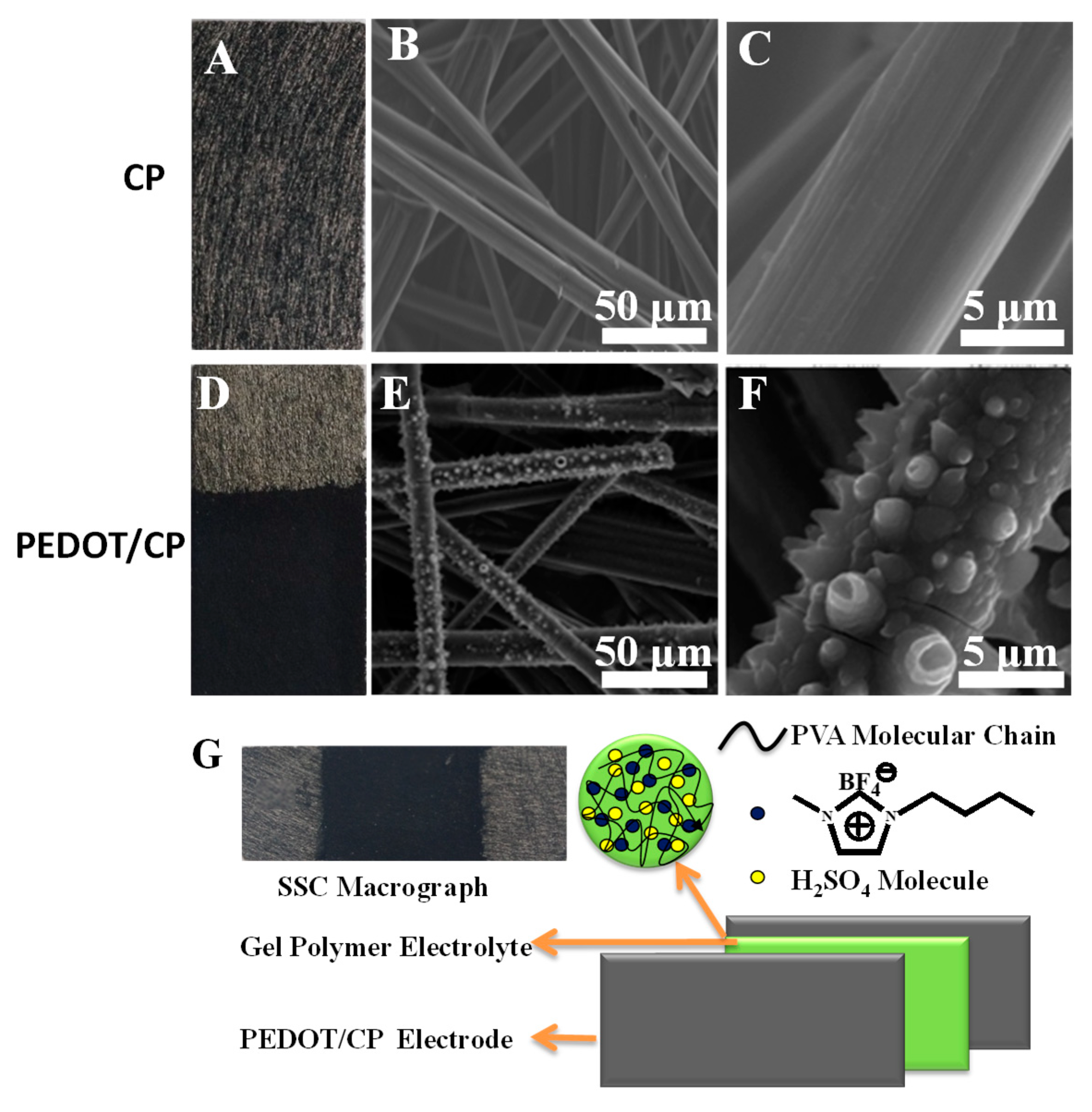
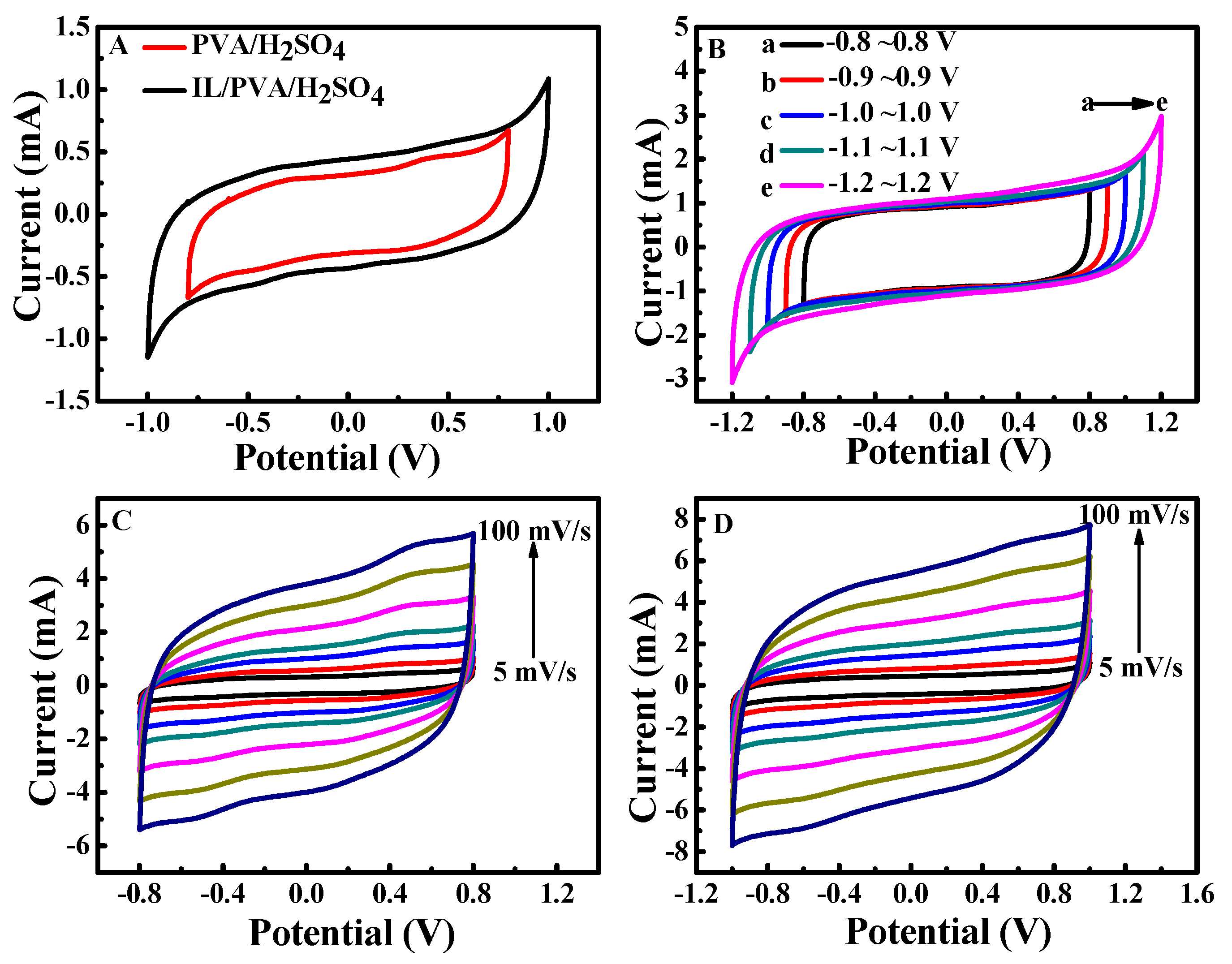
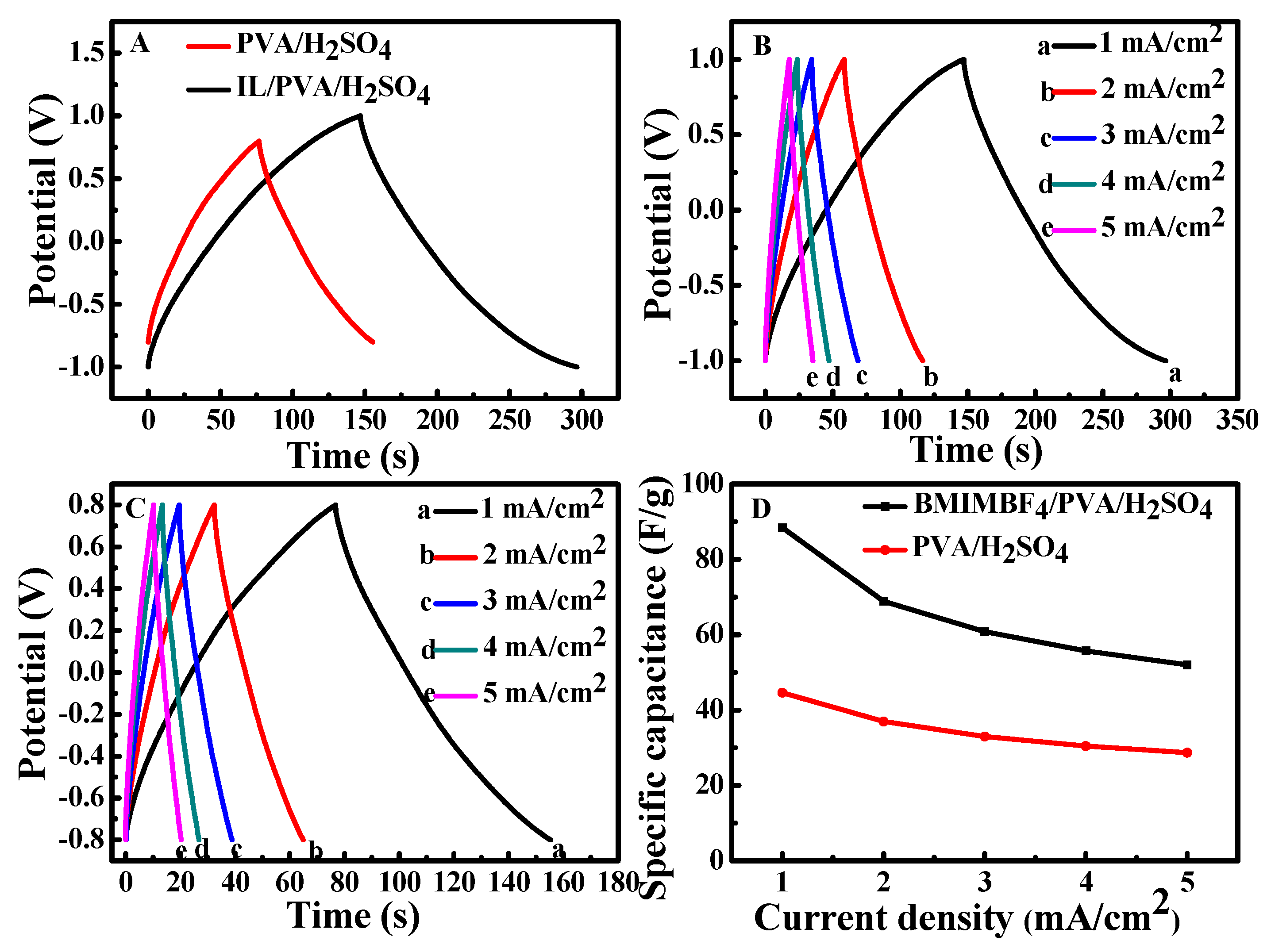
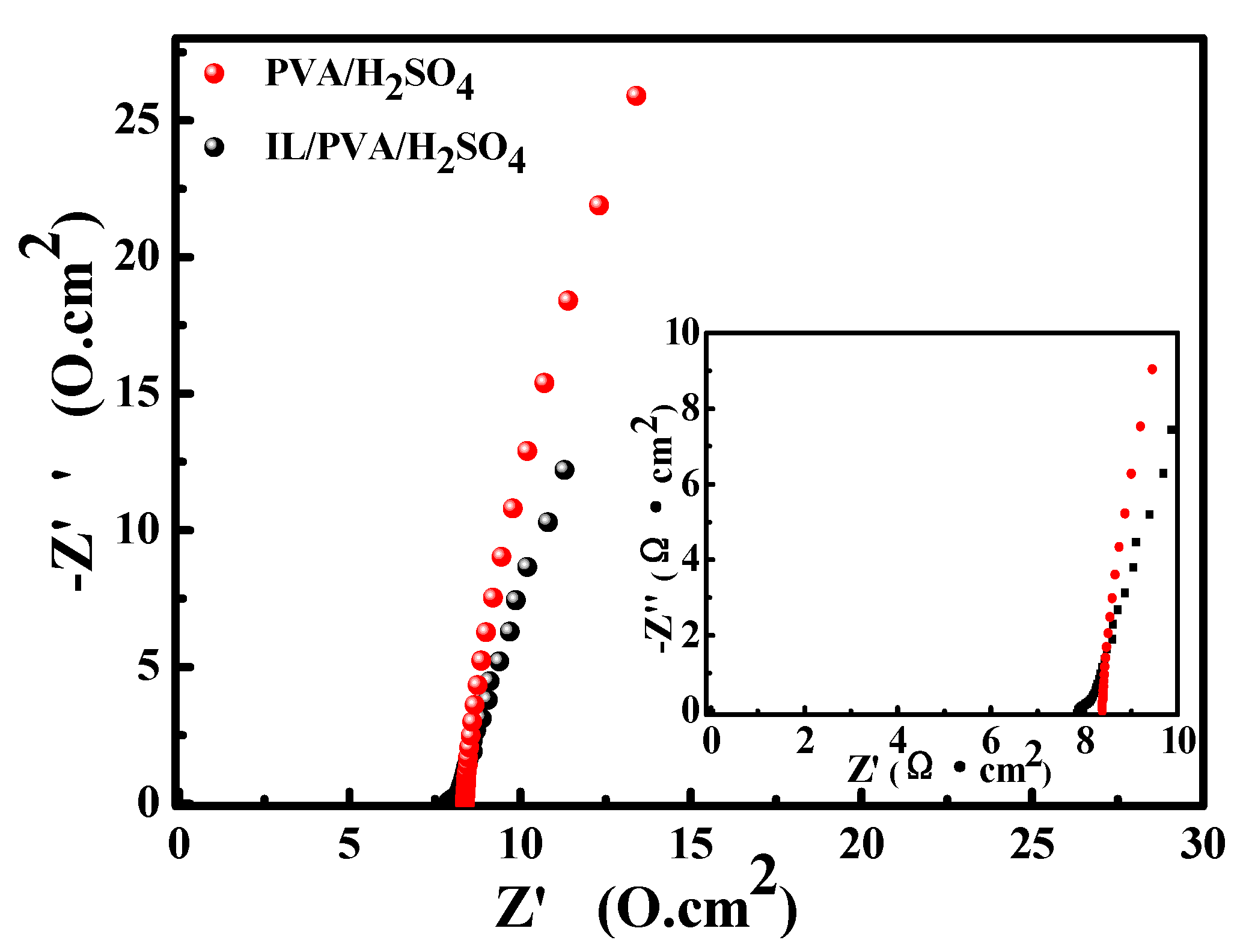
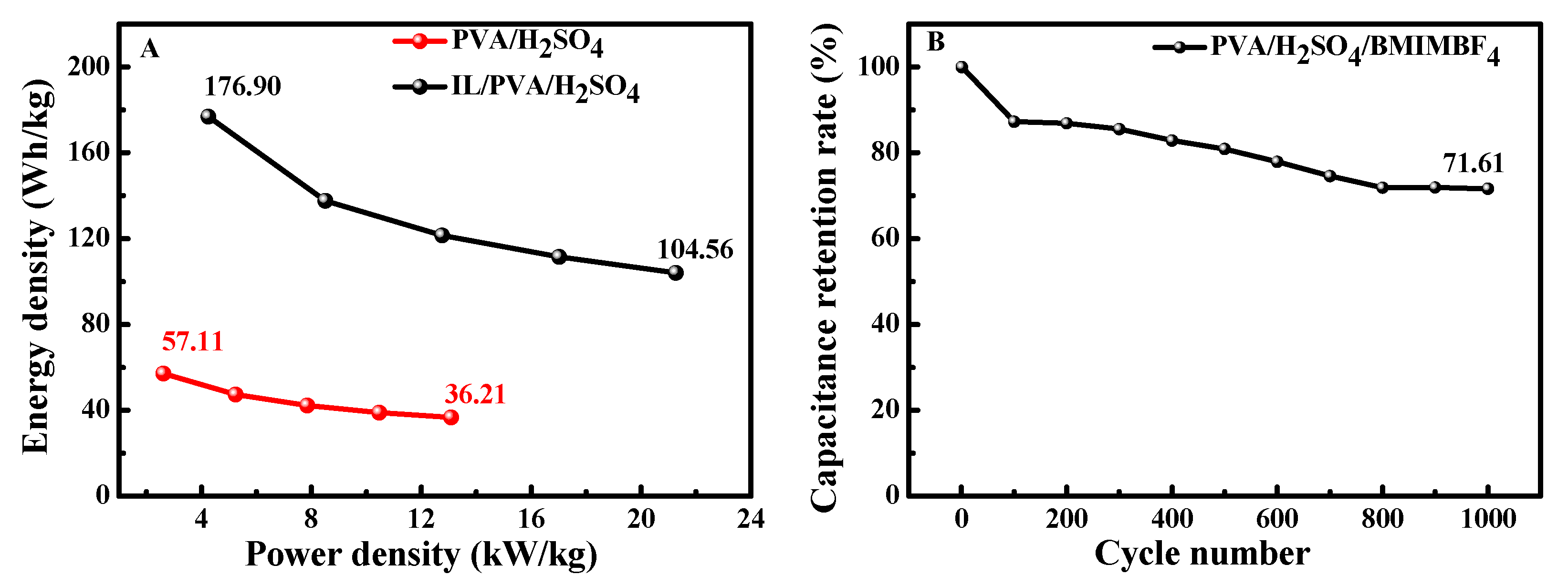
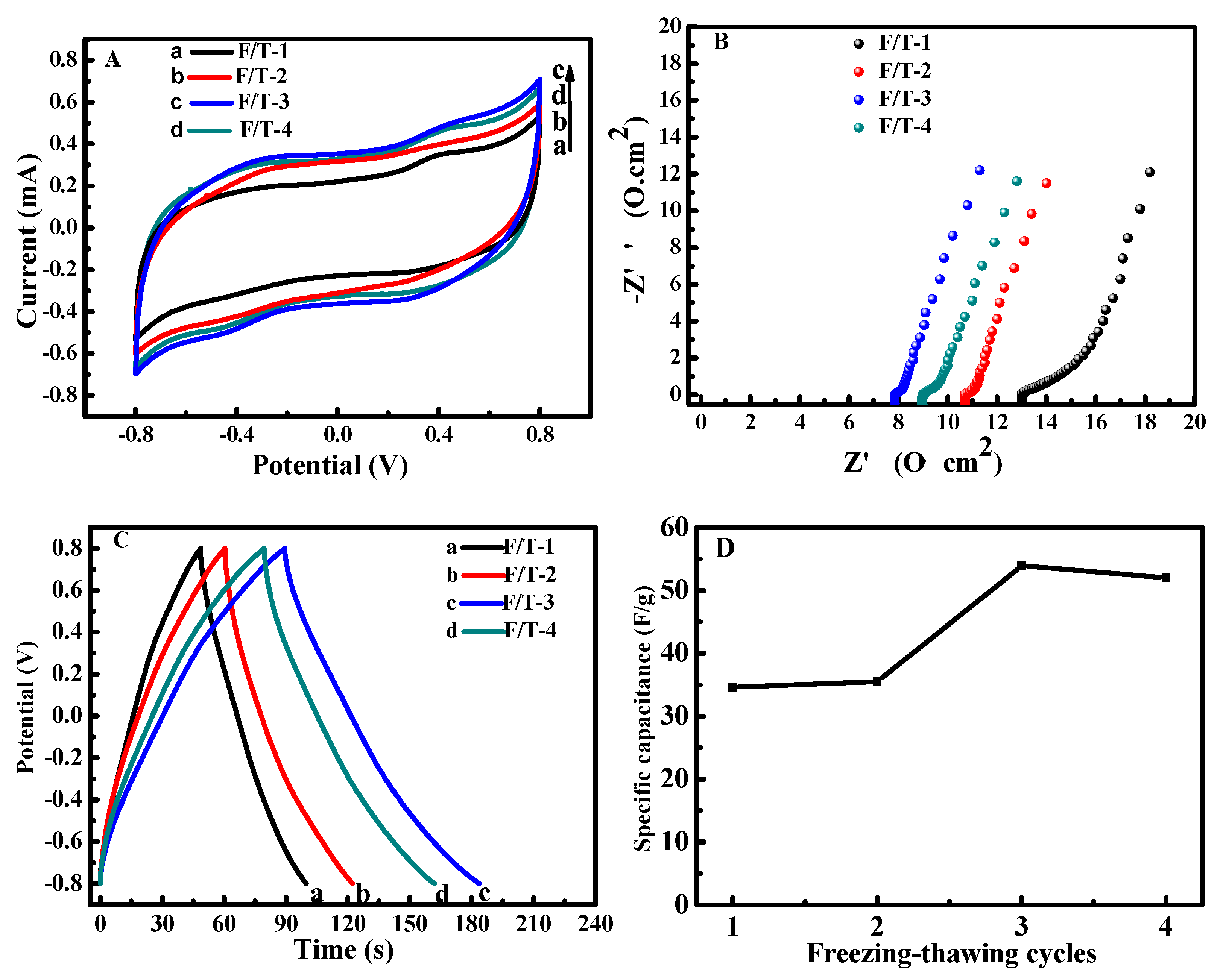
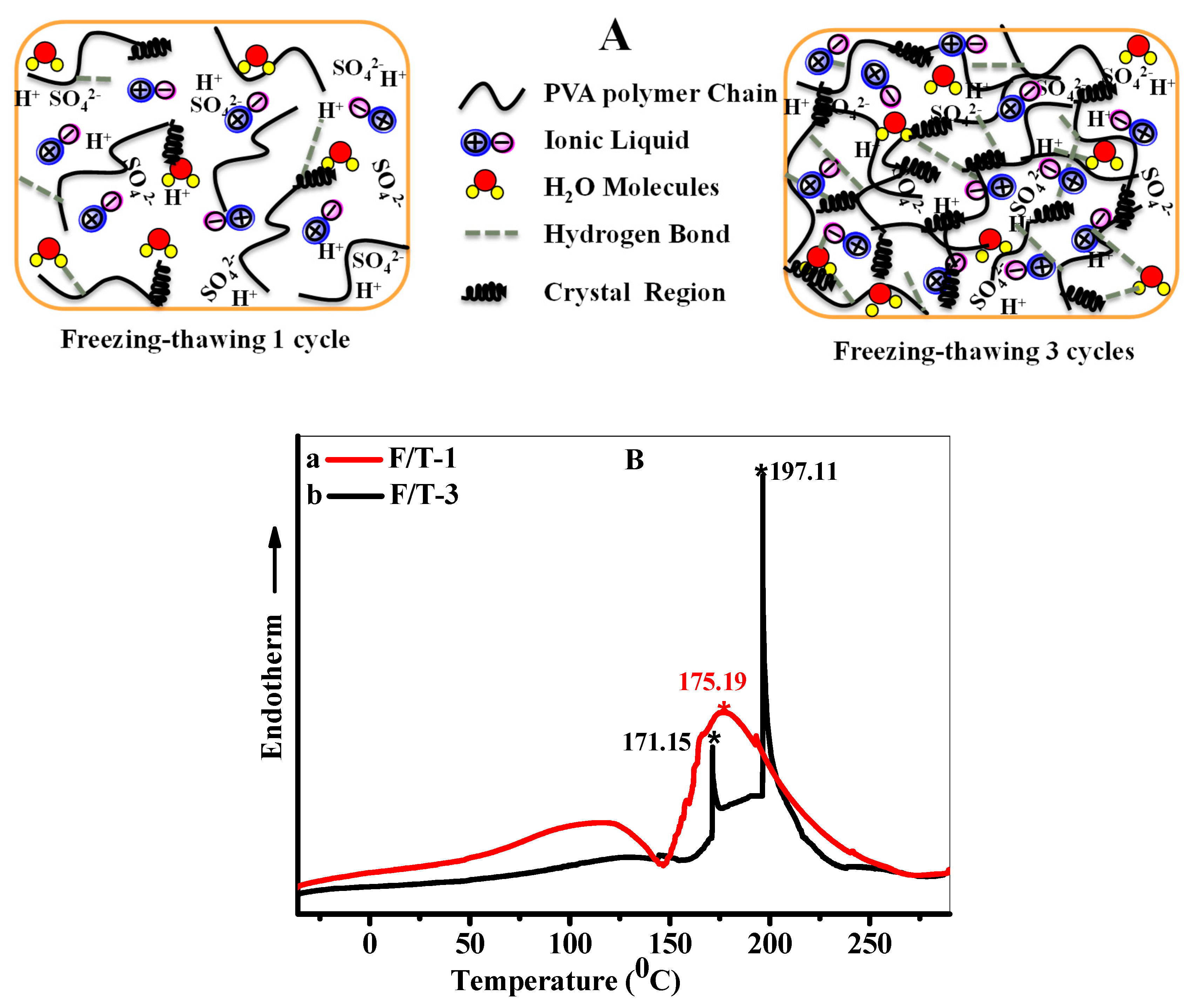
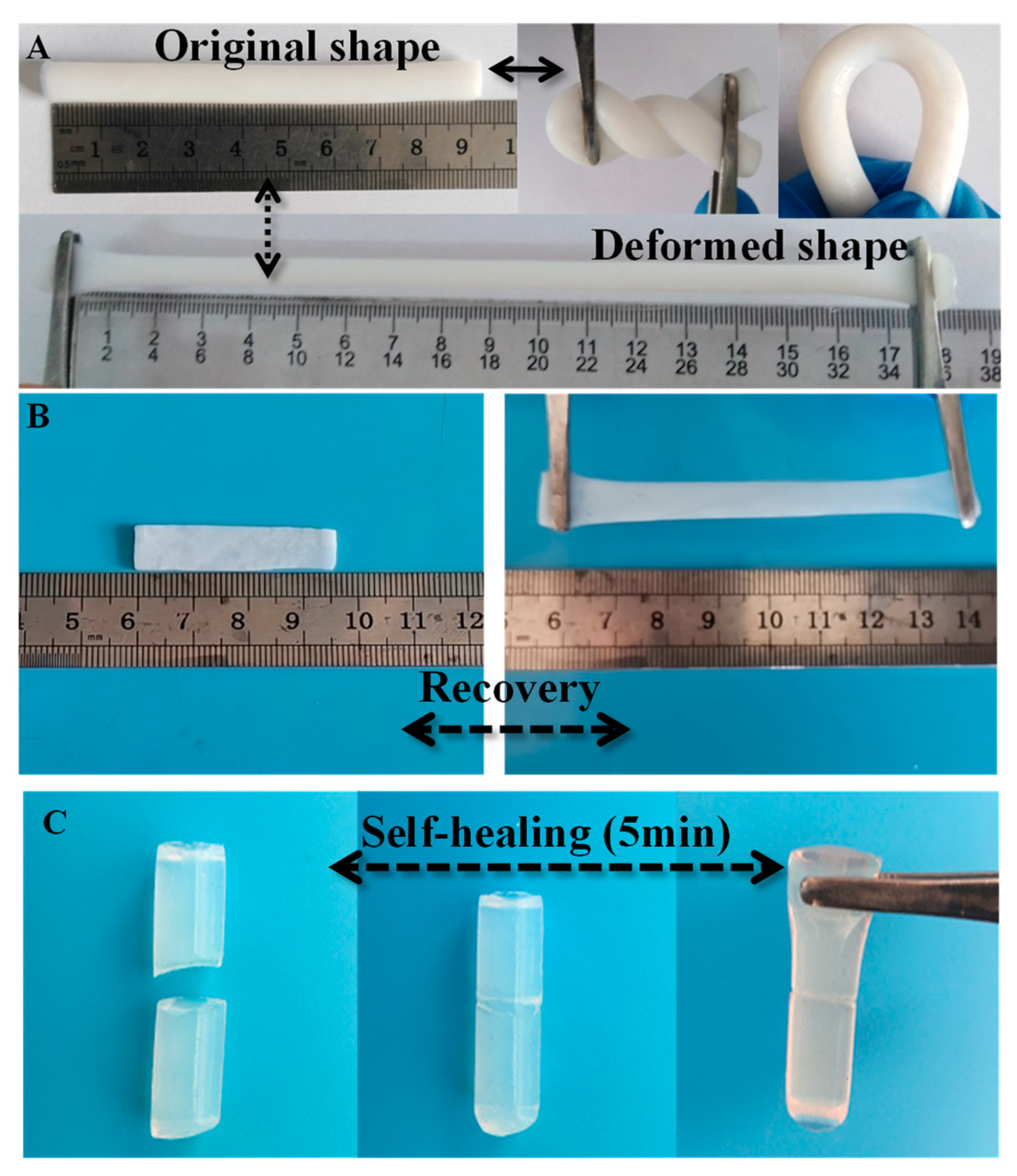
| Electrolyte | Rs (Ω·cm2) | Rct (Ω·cm2) | Conductivity (mS/cm) |
|---|---|---|---|
| PVA/H2SO4 | 8.38 | 0.010 | 38.36 |
| IL/PVA/H2SO4 | 7.90 | 2.608 × 10−3 | 90.09 |
| F/T Cycles | Rs (Ω·cm2) | Rct (Ω·cm2) | Cp (F/g) | Tm (°C) | Conductivity (mS/cm) |
|---|---|---|---|---|---|
| 1 | 13.00 | 1.013 × 10−7 | 34.47 | 175.19 | 68.81 |
| 3 | 7.90 | 2.608 × 10−3 | 53.73 | 197.11 | 90.09 |
© 2020 by the authors. Licensee MDPI, Basel, Switzerland. This article is an open access article distributed under the terms and conditions of the Creative Commons Attribution (CC BY) license (http://creativecommons.org/licenses/by/4.0/).
Share and Cite
Du, H.; Wu, Z.; Xu, Y.; Liu, S.; Yang, H. Poly(3,4-ethylenedioxythiophene) Based Solid-State Polymer Supercapacitor with Ionic Liquid Gel Polymer Electrolyte. Polymers 2020, 12, 297. https://doi.org/10.3390/polym12020297
Du H, Wu Z, Xu Y, Liu S, Yang H. Poly(3,4-ethylenedioxythiophene) Based Solid-State Polymer Supercapacitor with Ionic Liquid Gel Polymer Electrolyte. Polymers. 2020; 12(2):297. https://doi.org/10.3390/polym12020297
Chicago/Turabian StyleDu, Haiyan, Zemin Wu, Yuyu Xu, Shaoze Liu, and Huimin Yang. 2020. "Poly(3,4-ethylenedioxythiophene) Based Solid-State Polymer Supercapacitor with Ionic Liquid Gel Polymer Electrolyte" Polymers 12, no. 2: 297. https://doi.org/10.3390/polym12020297
APA StyleDu, H., Wu, Z., Xu, Y., Liu, S., & Yang, H. (2020). Poly(3,4-ethylenedioxythiophene) Based Solid-State Polymer Supercapacitor with Ionic Liquid Gel Polymer Electrolyte. Polymers, 12(2), 297. https://doi.org/10.3390/polym12020297





